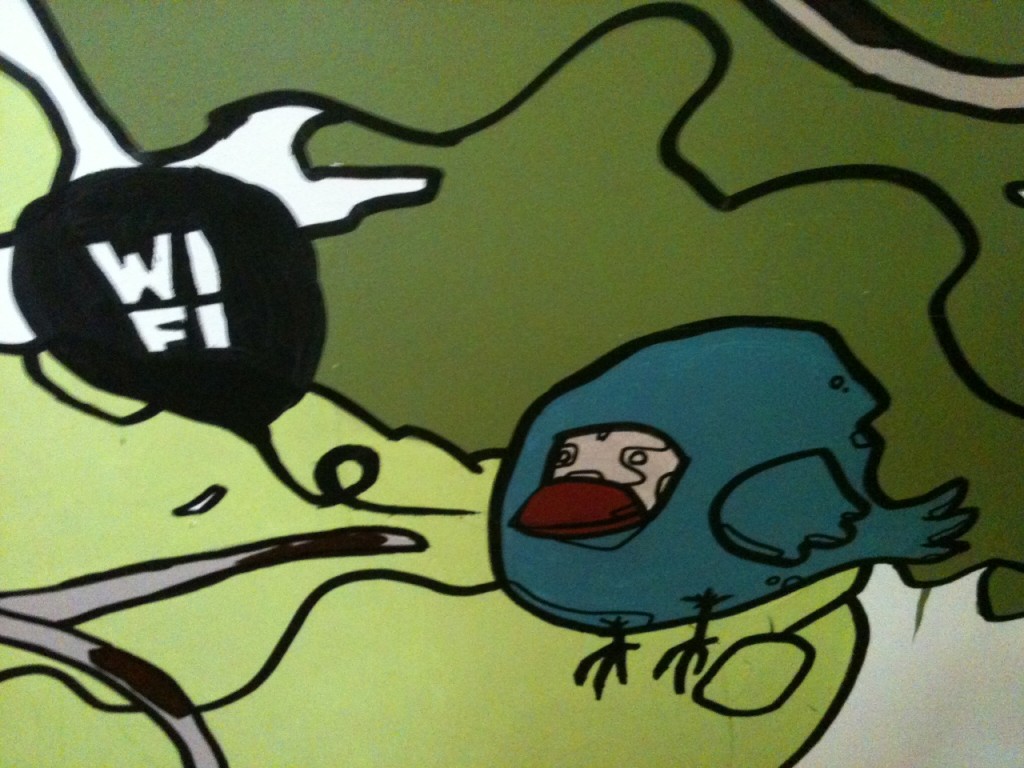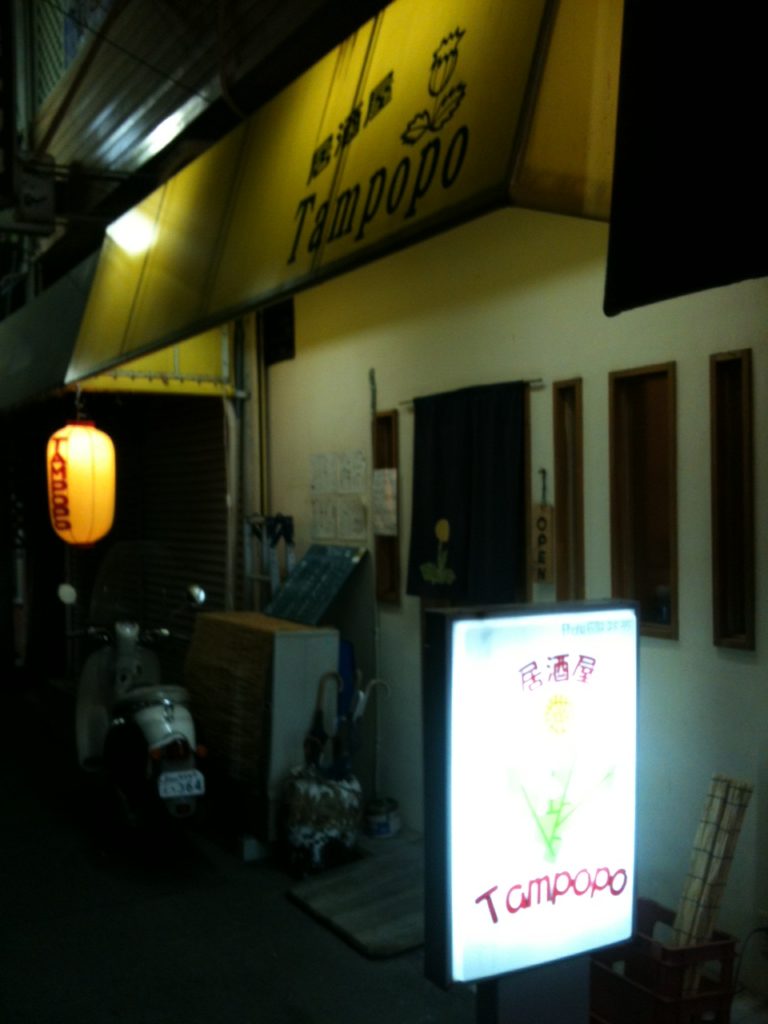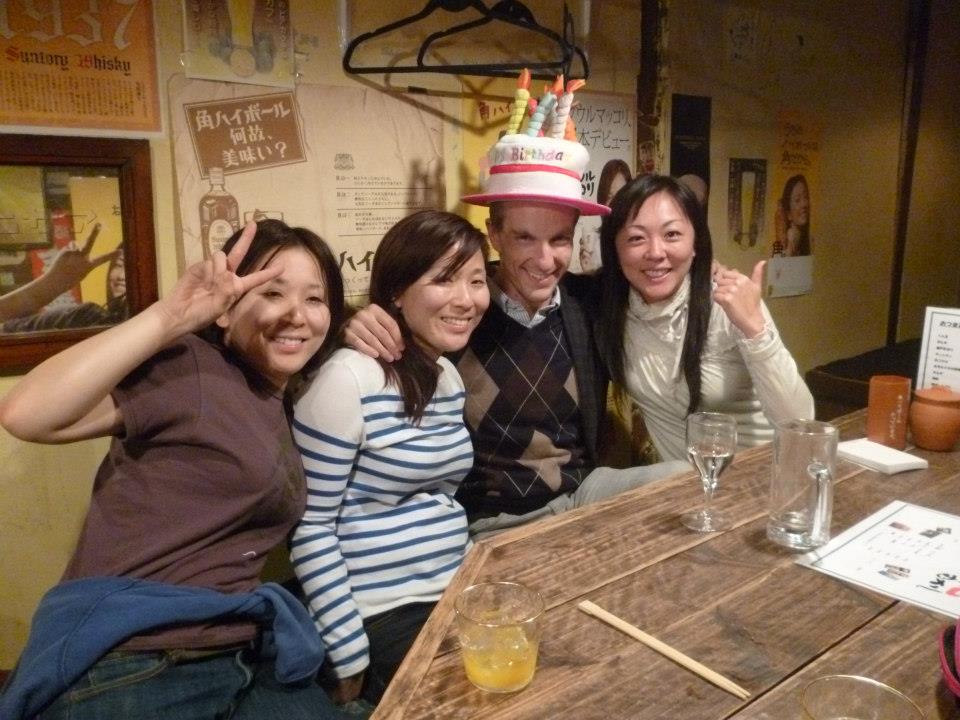
Suggestions for a truly modern traveler’s Japanese phrasebook:
“Does this coffee-shop have wi-fi?”
“Then what do those stickers on your windows with the word ‘wi-fi’ mean?”
“But why would I have to do all that just to connect?”
“Why don’t you know?”
In Japan, one doesn’t come by wi-fi hotspots easily; one doesn’t come by reliable wi-fi hotspots at all. I’d expect this in, say, Mozambique, but in William-Gibson-future-unequally-distributed here? Akky Akimoto sheds some light on this surprising inconvenience in The Japan Times:
In Japan, most demand for email and Web access outside the home has long been satisfied by mobile phone features such as NTT Docomo’s i-mode service, which began in 1999. Years before the age of the smartphone, on i-mode and its competitors, over 70 million users — the same amount as PC Web users —were enjoying Internet access through their phones (there were some limitations, but it was still the Internet). Flat-rate data plans (which only became common in the United States with the introduction of the iPhone in 2007), became available in Japan around 2004, and people began to do everything Net-related from their cellphones. For these users, there was no need for a network of free Wi-Fi at shops and cafes.
Instead, what people in urban areas of Japan wanted was to access the Web while they were on the train to work. People who spend 3 to 4 hours on their weekday commute boosted the cellphone-Web infrastructure. Making a simple Wi-Fi network within a cafe or store may be an easy task, but offering Wi-Fi to hundreds of thousands people on trains is not realistic. Cellphone access might not be as fast as Wi-Fi, but cellphones are capable of being connected on high-speed trains.
Keitai intanetto on their densha, eh? So that’s how these people play it. Nevertheless, I have found one reasonably handy source of wi-fi for the deadline-bound writing gaijin: Sutaabakkusu. They don’t charge you for it, though they do put you through a catch-22: you first must sign up for an account on the internet before they’ll connect you the internet. Having accomplished that, I’ve gone on to visit Starbucks more often in the past week in Japan than I have in the past year in Los Angeles. Drinking my shooto kappachiino, I reflect upon my own admiration for the fact that Japanese Starbucks actually displays the eight-ounce size on their menu. You can order a short in the States, but they sure as hell won’t make it obvious that they’ll deign to serve you such a non-prosperously modest cup.
But if you find yourself needing the net in Kyoto’s Kawaramachi shopping district, I suggest trying the more comfortable Second House. Walk just south of Sanjo Kawaramachi, go into the Mina Kyoto department store, and ride up seven floors. I conducted an interview there, then ate one of their special ebi-and-cheese quiches, then ordered a kappachiino. Then my phone informed me of their open wi-fi network, so I proceeded to break out the laptop and linger over my drink for the next two hours. Yet the connection still crapped out every ten minutes, just as Starbucks’ periodically slows to uselessness for no discernible reason. Japan, so I will generalize, richly mixes the impossibly advanced and the mystifyingly broken. For another instance, Sutaba (for short, as McDonald’s becomes “Makudo”) often attaches itself to and thus shares a bathroom with a swank hotel. There you’ll find only the cleanest, heatedest, most advanced Washlet toilets. Elsewhere, toilets make you squat. Little exists in between.
(“Not for pooping,” replied an interviewee when I asked if he’d yet made his peace with squat toilets after a year in Japan.)

If you opt for Second House, keep it to the daylight. Do your work there. “The places where you have fun after dark in Japan are always hidden. The unknowing foreigner walks along Tokyo’s Ginza or along Kawaramachi in Kyoto, lonely, little knowing that just a few blocks over are lanes of bars and blocks of cabarets.” So writes Donald Richie in The Inland Sea, his best-known book and the one I’ve brought along on this trip. The observation holds in the big cities of 2012 just as well as it did in the island hamlets of 1970. Take mere steps off of its main drags, and you’ll discover that Osaka is made of thousands of distinctively illuminated, aesthetically specialized 300-square-foot eateries and watering holes. Even my own temporary neighborhood, the relatively sleepy side of the Ikuno ward near Momodani station, boasts a veritable mini-labyrinth of compellingly tiny establishments along what are neither alleys nor proper streets.
I’ve walked by the little restaurant Tampopo an obsessive number of times. On each I consider entering, but its posted menu, over half of it written in kanji I don’t know, chills me. Intellectually, I realize I could probably just walk in, play the bumbling-gaijin card, and throw myself on the mercy of the no doubt non-English-speaking owners. They would simply serve me a house specialty, or I’d point to another customer’s dish and ask to have that. “Hai, hai, wakarimasu,” I would reply to their questions, the words — “yes, yes, I understand” — I use when I have understood nothing at all. That works, though in a maximally embarrassing fashion. Then again, just as I only learn a city by getting lost in that city, I only learn a language by making mistakes. Humiliation is education. These delightful-looking holes in the wall provide me not only with a prize on which to keep my eyes during Japanese study, but a reason — one of many, and more emerge daily — to return to Osaka soon. If on my next visit I cannot stroll into Tampopo with a modicum of confidence, otoko dewanai.
(My fixation on Tampopo in particular also comes from the fact that it shares a name with the finest comedy about the Japanese relationship with food to come out of the 1980s. And with its main character. And with that character’s ramen shop.)
Rest assured, though, that I do make mistakes in Japanese. I make so many mistakes. My first few days here, I tended to begin sentences in boldly Japanese and finish them having wandered into Korean. This began with the flight attendant serving me drinks:
“Tsumetai ocha kudasai.”
“Ah! Jyozu desu!”
“Iie, iie. Nihongo dekimasen, demo… kongbu hago isseoyo.”
I spent my birthday in Hiroshima, visiting Peace Park, the Atomic Bomb Dome, and Peace Memorial Museum. (Have at it with your jokes about the incongruity of the day and its activities; my lady has long since beat you to it.) These rounds I made with my friends Yoko, Tomoko, and Misa, whom I know from Mexico City. We conduct our conversations in a mixture of Japanese and Spanish, a hybrid tongue — Spapanese? — of which I hope to become, the proud Japanese Peruvians aside, the world’s foremost speaker. At one point, Yoko rightly admonished me for leaning so heavily on Spanish instead of seizing the opportunity to practice Japanese in the very land where people speak it. As we emerged from hall after hall of melted rubble, scorched flesh, and shredded school uniforms, Yoko told me of a friend who claimed that, after this harrowing viewing experience, she couldn’t eat for three days. Summoning my flawless command of her native language, I replied. “Wow! No eating, three months?”
With some regret, I inform you that I could eat immediately afterward. Not only did I eat, but I ate my share of three heaping Hiroshima-style okonomiyaki, with an enormous beer on the side. We all did. My friends even snapped pictures of the meal. Every notion about the Japanese being more enthusiastic about and better at casual photography is true. Whenever a waiter set dishes before us, all three ladies would whip out their cameras as if by instinct. I tried to take a picture of this, but they proved too quick on the draw every time. As a collective Baedeker to their homeland, Yoko, Tomoko, and Misa did well indeed, even taking me to the very sort of narrow, darkened, neatly cluttered, English-free drinking establishment to which I perpetually long for entry. Nobody brought the cake hat for the occasion; the bar just happened to have it sitting atop some immaculately piled junk. It also had an absolutely state-of-the-art toilet.

[Previous diaries: Seattle 2012, Portland 2012, San Francisco 2012, Mexico City 2011]
Post a Comment